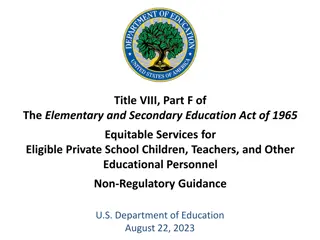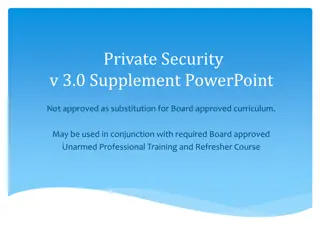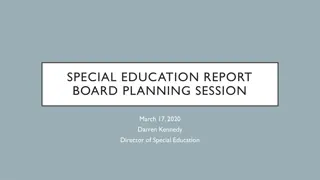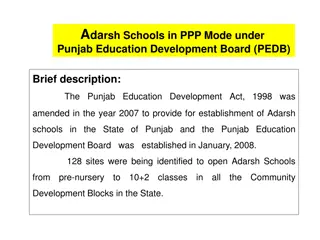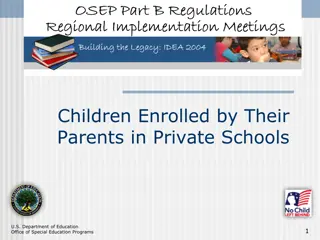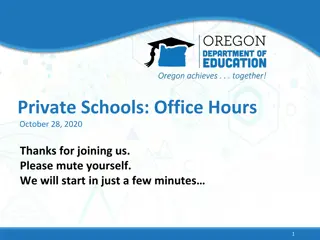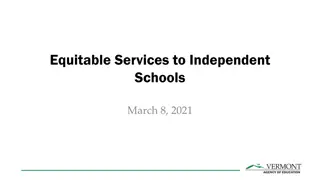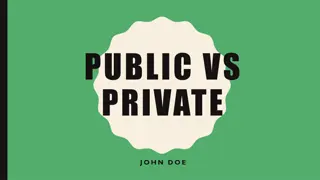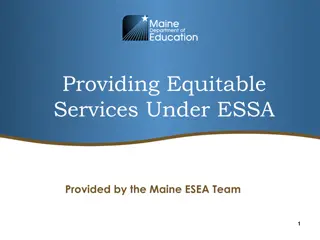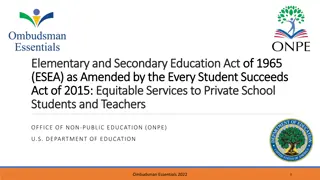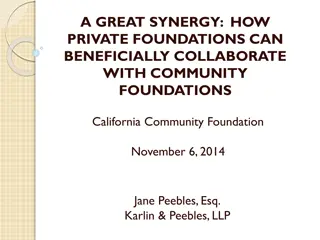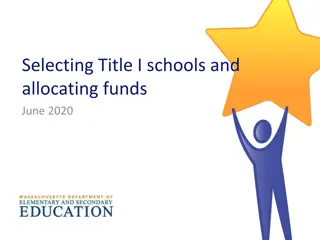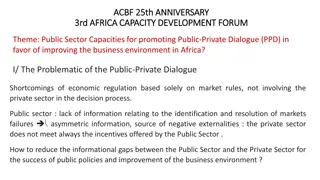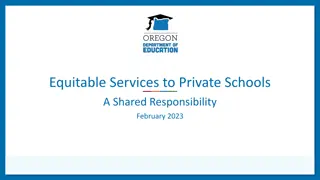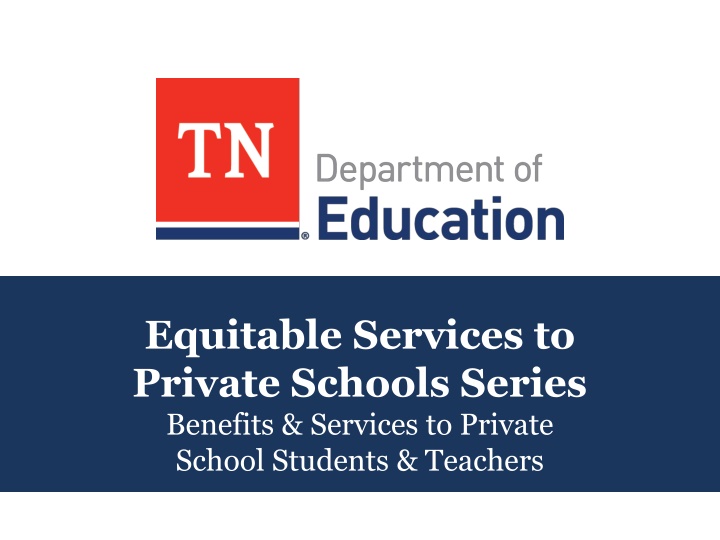
Equitable Services to Private Schools Series - Benefits and Services Overview
"Learn about the benefits and services provided to private school students and teachers through the Equitable Services to Private Schools Series. Understand the key programs under the ESEA that require equitable participation, ensuring a fair education system for all. Explore the background, agenda, and essential information outlined for private school involvement in educational programs."
Download Presentation

Please find below an Image/Link to download the presentation.
The content on the website is provided AS IS for your information and personal use only. It may not be sold, licensed, or shared on other websites without obtaining consent from the author. If you encounter any issues during the download, it is possible that the publisher has removed the file from their server.
You are allowed to download the files provided on this website for personal or commercial use, subject to the condition that they are used lawfully. All files are the property of their respective owners.
The content on the website is provided AS IS for your information and personal use only. It may not be sold, licensed, or shared on other websites without obtaining consent from the author.
E N D
Presentation Transcript
Equitable Services to Private Schools Series Benefits & Services to Private School Students & Teachers
Keith Woodruff Equitable Services and Charter Schools Coordinator Consolidated Planning & Monitoring Keith.Woodruff@tn.gov (615) 741-3385
Agenda Background and Overview Title VIII, Part E Uniform Provisions Title I, Part A (Improving Basic Programs) Title I, Part C (Education of Migratory Children) Title II, Part A (Preparing, Training, and Recruiting High- quality Teachers, Principals, and Other School Leaders) Title III, Part A (Language Instruction For English Learners and Immigrant Students) Title IV, Part A (Student Support & Academic Enrichment) Title IV, Part B (21st CCLC) 4
Background and Overview
Background and Overview The Elementary and Secondary Education Act (ESEA), as amended by the Every Student Succeeds Act (ESSA) requires districts to provide for the equitable participation of private school students, teachers and, in some cases, parents and other education personnel in some of the major programs. 6
ESEA Programs Requiring Equitable Participation Title I - Improving the Academic Achievement of the Disadvantaged Improving Basic Programs Operated by LEAs (Part A) Education of Migratory Children (Part C) 7
ESEA Programs Requiring Equitable Participation Title II Preparing, Training, and Recruiting High-quality Teachers, Principals, and Other School Leaders Supporting Effective Instruction State Grants (Part A) 8
ESEA Programs Requiring Equitable Participation Title III - Language Instruction for EL and Immigrant Students Language Instruction For English Learners and Immigrant Students (Part A) Title IV 21st Century Schools Student Support & Academic Enrichment (Part A) 21st Century Community Learning Centers (Part B) 9
Types of Federal Grants Formula Grants Predetermined formula Non-competitive Most grants are awarded to State Education Agency (SEA) Discretionary Grants Competitive grants to SEAs, districts, and/or other eligible entities Department has discretion in determining who receives the grant 10
Title VIII, Part E Uniform Provisions
Programs Requiring Equitable Services Covered Programs Title I, Part A (Improving Basic Programs) Title I, Part C (Education of Migratory Children) Title II, A (Preparing, Training, and Recruiting High-quality Teachers, Principals, and Other School Leaders) Title III, A (Language Instruction For English Learners and Immigrant Students) Title IV, A (Student Support & Academic Enrichment) Title IV, B (21st Century Community Learning Centers) 12
Equitable Services Requirements Districts are required to: engage in timely and meaningful consultation with private school officials; and provide private school students and teachers with an opportunity to participate in activities equivalent to the opportunity provided to public school students and teachers. 13
Equitable Services Requirements Additionally, districts are required to: assess and address the needs of private school students and teachers; provide benefits and services that meet the needs of private school students and teachers; and spend an equal amount of funds per student to provide services. 14
Eligible Students Private school students, enrolled in nonprofit private elementary and secondary schools, including those in religiously affiliated schools, located in the district, are generally eligible to receive services from that district. Some ESEA programs restrict eligibility or participation to a particular group of students, in which case the eligibility or participation of private school students likewise is restricted. A private school student s residency is not a factor, even if the student resides in a district and/or state that is different form the district and/or state in which the private school is located. 15
Consultation Timely and meaningful consultation between the district and private school officials during the design and development of the services is required on such issues as: how the children s needs will be identified; what services will be offered; and how and where the services will be provided. 16
Consultation Additionally, consultation should include such issues as: how the services will be assessed and how the results of the assessment will be used to improve those services; what service delivery mechanisms will be used to provide equitable services; who will provide the services; and the amount of funds available to serve private school students. 17
Consultation Moreover, consultation should include such topics as: the size and scope of the services to be provided; how and when the agency will make decisions about the delivery of services; and consideration of the views of the private school officials regarding use of third-party providers. 18
Consultation Topics Expanded Topics subject to consultation have also been expanded to include whether to provide equitable services to eligible private school participants: by creating a pool or pools of funds with all of the funds allocated under programs covered under 8501(b), or on a school-by-school basis based on each the proportionate share of funds available to provide services in each school. 19
Consultation Finally, it should be noted that: consultation must continue throughout the implementation and assessment of services; and such consultation shall occur before the district makes any decision that affects the opportunities to participate of eligible private school children, teachers, and other education personnel. 20
Expenditures Expenditures for equitable services for programs governed by Title VIII for private school students must be equal to those of public school students on a per-pupil basis, taking into account the number and the education needs of children to be served. The district remains in control of the federal funds and maintains ownership of materials, equipment, and property purchased with such funds. 21
Complaints If private school officials believe timely and meaningful consultation has not occurred, they should discuss this with the district, then if needed, with the SEA s ombudsman. In the event the issue is unresolved, private school officials have the right to file a formal written complaint to the ombudsman. A formal complaint must include: a statement that a violation of the equitable services requirement has taken place, the facts on which the statement is based, and the signature of the complainant.
Complaints Non-public schools may file a complaint with the state s ombudsman if they believe that: timely and meaningful consultation did not occur; the district did not give due consideration to the views of the non-public school officials; or the funds generated or services to be provided are not equitable. 23
Complaints A sample complaint form will be available on ePlan under TDOE Resources and on the department s website. Private schools must send the complaint to the district and the SEA. The district must upload to ePlan the complaint concerning equitable services and all documents they want to be considered by the ombudsman. The timeframe for the ombudsman s response is 45 days. 24
Title I, A Improving Basic Programs Operated by LEAs
Purpose Ensure that all children served by the program have a fair, equal, and significant opportunity to obtain a high-quality education and reach, at a minimum, proficiency on challenging state academic achievement standards* and state academic assessments.* *or other more appropriate standards and/or assessments for private school Title I students as determine by an LEA after consultation. 26
Examples of Available Services for Eligible Private School Students Instruction outside the regular classroom; Extended learning time (before and after school and in the summer); Family literacy programs; Early childhood education programs; Counseling; Home tutoring; Instruction using take-home computers; Computer-assisted instruction; and A combination of services listed above. 27
Consultation Timely and meaningful consultation between the district and private school officials during the design and development of the services is required on such issues as how children s needs will be identified; what services will be offered; how and when decisions about the delivery of services will be made; how, where, and by whom services will be provided; how services will be assessed and improved based upon assessment results; the size and scope of services; and proportion of funds allocated for services. 28
Consultation Timely and meaningful consultation between the district and private school officials should also include: the method of determining poverty; equitable services to teachers and parents of participants; thorough analysis of the views of private school officials regarding third-party contractor; what service delivery mechanisms will be used to provide equitable services; and where the district disagrees with the views of the private school official on the provision of services through a contract, the district shall provide to the official a written explanation of the reasons why the district has chosen not to use a contractor. 29
Consultation Consultation must: include meetings of the district and private school official; occur before the district makes any decision that affects the opportunities of eligible private school children to participate in programs; and continue throughout the implementation and assessment of services. 30
Control of the Program The district must maintain control of the Title I funds, materials, equipment, and property. The district must provide assurances that it will: administer the program in accordance with all applicable statutes and regulations; and maintain control of the program. 31
Control of the Program The district is not required to match their supports and services with Title I to supports in non-public program(s). For example, if public schools are focusing Title I services in grades K 2 (in a K 8 school), the non- public is not restricted to serve only grades K 2. The non-public could serve additional grade spans if determined through consultation and collaboration. 32
Equitable Funding for Students The total amount expended by the district for services to eligible private school children must be proportionate to the amount of funds generated by private school students. Private school students generally must receive an equitable amount off the top of the Title I allocation before calculating funds for public school students.
Equitable Services for Families Districts are required to calculate funds based on their total Title I allocation to carry out required parental involvement activities.1 Districts are required to reserve the calculated funds for parental involvement activities from the private school portion allocated for Title I.2 1 Title I 1118 2 Title I 200.65
Assessments The district must annually assess private school Title I participants, using the state assessments or other more appropriate assessments, as determined in consultation. In consultation with private school officials, the district must define annual progress for private school Title I participants. If annual progress is not met, the district must modify the Title I program. Note: The Title I requirements for state to test all students annually does not apply to private schools. 35
Student Identification The children must reside in a participating public school Title I attendance area AND are failing or most at risk of failing to meet high standards. Children are selected on the basis of multiple educationally related, developmentally appropriate criteria. It should be noted poverty is NOT a criterion. The district chooses children to be served from the list that the private school provides of eligible students. 36
Title II, A Supporting Effective Instruction State Grants
Purpose To increase student academic achievement through strategies such as improving teacher and principal quality and increasing the number of highly effective teachers in the classroom and highly effective principals and assistant principals in schools. Districts may use Title II, A funds for a variety of teacher- quality activities that may or may not include professional development. However, services for private school teachers and other educational personnel must be for professional development.
Expenditures The amount a district must reserve to provide equitable services for private school teachers and other educational personnel for Title II, Part A services is based on the district s total Title II, Part A allocation, less administrative costs. 39
Expenditures The district determines the amount of funds available for Title II, Part A equitable services for private school teachers and other educational personnel by calculating, on a per-pupil basis, the amount available for all public and private school students enrolled in participating private elementary and secondary schools in areas served by the district (regardless of a student s residency), taking into consideration the number and needs of the children, their teachers and other educational personnel to be served. 40
Equitable Services: Title II, A Districts are encouraged to complete the Title II, A Equitable Services Worksheet to determine allocations. This worksheet is located in the Related Documents section of the Consolidated Funding Application. Formula for Title II, A Equitable Expenditures A. Number of Students A.1: District Enrollment (3rd mo ADM) A.2: Participating Private School Enrollment (Spring Private School Survey responses) A.3: Total Enrollment (A1+A2) B. Title II, Part A 42360 3911 46271 B.1: District Allocation B.2: Administration Costs (for public and private school programs) B.3: LEA Allocation Minus Admin Costs (B1-B2) C. Per Pupil Rate 1,903,330.00 $ 298,315.00 $ 1,605,015.00 $ C.1 B3 divided by A3 D. Equitable Services $ 34.69 D.1: Amount district must reserve for equitable services for participating private schools (A2xC1) 135,661.94 $
Equitable Services Districts must assess the needs of private school teachers and other educational personnel when designing the professional development program for private school teachers and those personnel and provide services that meet the needs of the private school teachers. If the professional development needs of the private school teachers and other educational personnel are different from those of public school teachers and personnel, the district, in consultation with private school officials, should provide different services. 42
Eligible Activities Professional development activities may include: Improving the knowledge of teachers, principals, and other educational personnel in effective instructional teaching strategies, methods, and skills necessary to enable students to succeed in a well-rounded education and to meet the challenging state academic standards Training in effectively integrating technology into curricula and instruction Training on how to teach students with different needs, including students with disabilities or limited English proficiency, and gifted and talented students 43
Eligible Activities Additionally, other professional development activities may include: Training on methods to improve student behavior, identifying early and appropriate interventions, and involving parents more effectively in their children s education Leadership development and management training to improve the quality of principals and superintendents Training in the use of data and assessments top improve instruction and student activities 44
Clarification of Well-rounded Education The term well-rounded education refers to: English/reading or language arts/writing, mathematics, science, technology, engineering, computer science, foreign languages, civics and government, economics, arts and music history and geography, career and technical education, and healthy, physical education. 45
Title III, A Language Instruction For EL and Immigrant Students
Purpose To help ensure that English learners (ELs) attain English language proficiency and meet the same standards that all children are expected to meet Services are provided to private school students, their teachers, and other education personnel and are considered assistance to students and teachers rather than private schools themselves.
Purpose The provision for Title III includes services and benefits, not funds, designed and implemented by the district in consultation with private school officials, to meet the needs of teachers and private school students. The Title III, A program (Title III) is subject to the equitable services requirements in the Title VIII Uniform Provisions of the ESEA. These requirements apply to districts awarded subgrants under the Title III English Learners State Grants. 48
Eligible Activities Some examples of Title III services a district may provide to private school ELs, their teachers, and other educational personnel include: administration of English language proficiency (ELP) assessments for identification and/or for the purpose of evaluating the effectiveness of services (test booklets, teacher training, stipends to teachers to administer assessments); participation in district-sponsored professional development (PD), or PD organized specifically to meet the needs of the private school teachers; tutoring for students before, during, or after school hours; 49
Eligible Activities (Continued) participation of private school ELs in summer school; participation of students in a weekend program; and purchase of supplemental instructional materials and supplies 50

